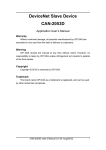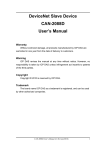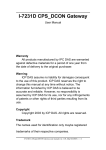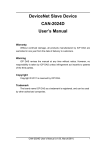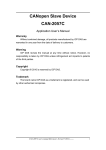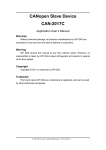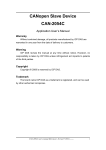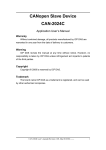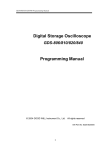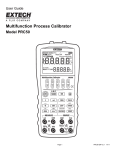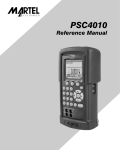Download User`s Manual - ICP DAS USA`s I
Transcript
DeviceNet Slave Device CAN-2018D User’s Manual Warranty Without contrived damage, all products manufactured by ICP DAS are warranted in one year from the date of delivery to customers. Warning ICP DAS revises the manual at any time without notice. However, no responsibility is taken by ICP DAS unless infringement act imperils to patents of the third parties. Copyright Copyright © 2011 is reserved by ICP DAS. Trademark The brand name ICP DAS as a trademark is registered, and can be used by other authorized companies. CAN-2018D User’s Manual (v1.00, Aug/2011) 1 Contents 1 2 3 Introduction.............................................................................................3 1.1 Overview.........................................................................................3 1.2 Hardware Specifications ...............................................................4 1.3 Features..........................................................................................5 1.4 Application .....................................................................................5 Hardware .................................................................................................6 2.1 Structure.........................................................................................6 2.2 Node ID & Baud Rate Rotary Switch ............................................7 2.3 LED Description .............................................................................8 2.4 PIN Assignment .............................................................................9 2.5 Wire Connection ..........................................................................10 2.6 Internal I/O Structure ................................................................... 11 DeviceNet Profile Area .........................................................................12 3.1 DeviceNet Statement of Compliance..........................................12 3.2 Identity Object (Class ID: 0x01) ..................................................13 3.3 Connection Object (Class ID:0x05) ............................................14 3.4 Assembly Object (Class ID: 0x04) ..............................................15 3.5 Application Object1 (Class ID: 0x64)..........................................17 3.6 Application Object2 (Class ID: 0x65)..........................................19 4 Application ............................................................................................21 Appendix A: Dimension...............................................................................23 Appendix B: Type Code Definition .............................................................24 CAN-2018D User’s Manual (v1.00, Aug/2011) 2 1 Introduction 1.1 Overview DeviceNet is one kind of the network protocols based on the CAN bus and mainly used for the embedded network such as industrial machine control, factory automation, medical equipments control, remote data acquisition, environmental monitoring, and packaging machines control, etc. The CAN-2018D follows DeviceNet specification Volume I/II, Release 2.0. You can obtain the analog input data and configure the module via standard DeviceNet protocol. To build a connection between DeviceNet master and the CAN-2018D is no more a tough project. The DeviceNet EDS file would help you to achieve this purpose quickly and easily. This module has 8 analog input channels for measuring the thermocouples or voltage values. It can be fit to various applications. By using the DeviceNet masters of ICP DAS, you can simply build a DeviceNet network for your requirements. CAN-2018D User’s Manual (v1.00, Aug/2011) 3 1.2 Hardware Specifications Analog Input: z Input Channels: 8 z Input Type: +/- 15mV, +/- 50mV, +/- 100mV, +/- 500mV, +/- 1V, +/2.5V, -20mA ~ +20mA (Requires Optional External 125Ω Resistor) z z z z z z Thermocouple(J, K, T, E. R. S, B, N, C) Resolution: 16-bit Accuracy: +/-0.1% FSR Sampling Rate: 10 Samples/ sec (Total) Zero Drift: +/- 10μV/ °C Span Drift: +/- 25 ppm/ °C Common Mode Rejection: 86 dB z z z z z z z Normal Mode Rejection: 100 dB Input Impedance: >400 kΩ Individual Channel Configuration: Yes Open Thermocouple Detection: Yes Over voltage Protection: 240 Vrms 4KV ESD Protection: Yes, Contact for each terminal. Intra-module Isolation, Field to Logic: 3000 VDC Others: z Power LED: PWR (red) z DeviceNet Status Led: NET/MOD, green/orange z Power Supply: Unregulated +10 ~ +30 VDC. z Power Consumption: 1.5 W. z Operating Temperature: -25 ~ 75 ℃. z Storage Temperature: -30 ~ 80 ℃. z z Humidity: 10 to 90% RH, Non-condensing. Dimensions: 32.3 mm x 99 mm x 78 mm (W x L x H) Detail. CAN-2018D User’s Manual (v1.00, Aug/2011) 4 1.3 Features z z z z z z z z DeviceNet general I/O slave device Comply with DeviceNet specification Volume I, Release 2.0 & Volume II, Release 2.0, Errata 5 Group 2 Only Server (non UCMM-capable) Support Predefined Master/Slave Connection Set Connection supported: 1 connection for Explicit Messaging 1 connection for Polled I/O 1 connection for Bit-Strobe I/O connection Support DeviceNet heartbeat and shutdown messages Provide EDS file for standard DeviceNet master interface. NET, MOD and PWR LED indictors 1.4 Application CAN-2018D User’s Manual (v1.00, Aug/2011) 5 2 Hardware 2.1 Structure (Top View) (Bottom View) CAN-2018D User’s Manual (v1.00, Aug/2011) 6 2.2 Node ID & Baud Rate Rotary Switch The rotary switches of node ID configure the node ID of CAN-2018D module. These two switches are numbers in base ten. For example, the node ID value of the following picture is 32. Node ID rotary switch The rotary switch about the baud rate configuration handles the CAN baud rate of CAN-2018D module. The relationship between the rotary switch value and the practical baud rate is presented in the following table. Baud rate rotary switch Rotary Switch Value Baud rate (kbps) 0 125 1 250 2 500 CAN-2018D User’s Manual (v1.00, Aug/2011) 7 2.3 LED Description PWR LED The CAN-2018D is powered by 10 ~ 30 VDC. Under a normal connection, a good power supply and a correct voltage range selection, as the unit is turned on, the LED will light up in red. NET LED The NET LED indicates the current status of the DeviceNet communication link. Condition status Indicates Init Off Off line Device is not online Off Connection timeout I/O connection timeout Flashing On line Device is on line, but not communicating Init solid Link failed (Critical) Device has detected an error that has rendered it incapable of communicating on the link; for example, detected a duplicate node address or network configuration error Solid On line, communicating Device is online and communicating MOD LED This LED provides the devices status. It indicates whether or not the device is operating properly. Condition status Indicates Off Normal Solid Critical fault Device has unrecoverable fault. Flashing Non_critical fault Device has recoverable fault to recover. If users want to fix the problem, reconfiguring device’s MAC ID or resetting device may work. CAN-2018D User’s Manual (v1.00, Aug/2011) 8 2.4 PIN Assignment CAN-2018D + CN-1824 (transformation connector) CAN-2018D 25-pin Female D-Sub Connector CAN-2018D User’s Manual (v1.00, Aug/2011) 9 2.5 Wire Connection CAN-2018D User’s Manual (v1.00, Aug/2011) 10 2.6 Internal I/O Structure CAN-2018D User’s Manual (v1.00, Aug/2011) 11 3 DeviceNet Profile Area This section describes the detailed functions for each object class that is implemented in the CAN-2018D DeviceNet network. 3.1 DeviceNet Statement of Compliance General Device Data Device Information Version Description Specification of Description DeviceNet Volume I, Release 2.0 & Volume II, Release 2.0 Vendor Name ICP DAS Device Profile Name CAN-2018D Production Revision 1.1 DeviceNet Physical Conformance Data Item Description MAC ID Setting Switch (0 ~ 63) Communication Baud Rate Setting Switch (125, 250, 500 kbps) Default Baud Rate 125 kbps Predefined Master/Slave Connection Group 2 Only Server Set CAN-2018D User’s Manual (v1.00, Aug/2011) 12 3.2 Identity Object (Class ID: 0x01) This object provides the identification and general information about the device. Class Attribute (Instance ID=0) Attribute ID Attribute name Data Type Method Value 0x01 Revision UINT Get 0001 0x02 Max Instance UINT Get 1 Class Service Service Code Service name Support 0x0E Get_Attribute_Single Yes Instance Attribute (Instance ID=1) Attribute ID Description Method DeviceNet Data Type Value 1 Vendor Get UINT 803 2 Product type Get UINT 0x00 3 Product code Get UINT 0x300 4 Major. Minor of firmware version Get Struct of USINT USINT 1.1 5 Status Get WORD - 6 Serial number Get UDINT 1 7 Product name Get Short_String CAN-2018D 10 Heartbeat Interval Get/Set USINT 0(default) Instance Service Service Code Service name Support 0x0E Get_Attribute_Single Yes 0x10 Set_Attribute_Single Yes 0x05 Reset Yes Note: Use the Instance Service 0x05 will reboot the device. CAN-2018D User’s Manual (v1.00, Aug/2011) 13 3.3 Connection Object (Class ID:0x05) This section presents the externally visible characteristics of the Connection Objects associated with the Predefined Master/Slave Connection Set within slave devices. The default IO connection path is as follow. Connection Path Class ID Instance ID Attribute ID Poll Produced 0x04 0x64 0x03 Poll Consumed 0x65 0x01 0x01 Bit Strobe Produced 0x04 0x64 0x03 Bit Strobe Consumed 0x65 0x01 0x01 Connection Instance ID Description 1 References the Explicit Messaging Connection into the Server 2 References the Poll I/O Connection 3 References the Bit–Strobe I/O Connection CAN-2018D User’s Manual (v1.00, Aug/2011) 14 3.4 Assembly Object (Class ID: 0x04) The Assembly Object binds attributes of multiple objects, which allows sending / receiving the data from / to each object over a single connection. Assembly objects can be used to bind input data or output data. The terms of ”input” and ”output” are defined from the network’s point of view. An input will produce data on the network and an output will consume data from the network. Class attribute (Instance ID=0) Attribute ID Attribute name Data Type Method Value 0x01 Revision UINT Get 1 0x02 Max Instance UINT Get 0x03 Class service Service Code Service name Support 0x0E Get_Attribute_Single Yes Instance ID Instance ID OUTPUT 0x64 0x65 0x66 INPUT Get values of all AI channels Type codes of all AI channel Offset values of all AI channels Get type codes of all AI channels Get offset values of all AI channels Node: About the definition of the type codes, please refer to the appendix B for details. CAN-2018D User’s Manual (v1.00, Aug/2011) 15 Contents of Each Assembly Object Instance Instance ID 0x64 0x65 0x66 Description Type Method Default Value Get Channel 0 ~ 7 AI values UINT … UINT 0x0000 … 0x0000 Get/Set Channel 0 ~ 7 AI type codes USINT … USINT 0x0E … 0x0E Get/Set Channel 0 ~ 7 AI offset values UINT … UINT 0x0000 … 0x0000 Parameter description of Assembly Object Instance Instance ID Data Range 0x64 Refer to Appendix B for the corresponding input values Channel 0~7 input values 0x65 Refer to Appendix B for the type code definition Channel 0~7 AI type codes 0x0000 ~ 0xFFFF Channel 0~7 AI offset value 0x0000 ~ 0x7FFF => 0 ~ +32767 0xFFFF ~ 0x8000 => -1 ~ -32768 0x66 Parameter Description Instance attribute (Instance ID=0x64~0x68) Attribute ID Description Method DeviceNet Data Type Value 0x03 Data Get/Set OUTPUT/ INPUT Dependent on instance ID Instance service Service Code Service name Support 0x0E Get_Attribute_Single Yes 0x10 Set_Attribute_Single Yes CAN-2018D User’s Manual (v1.00, Aug/2011) 16 3.5 Application Object1 (Class ID: 0x64) Application objects are the interfaces between an application and the DeviceNet Layer. The attributes of application Objects contain the data for the application, which are accessed and exchanged via the DeviceNet protocol. A DeviceNet device accesses application data by invoking read and write functions. These functions need to be provided by an Application Object. The DeviceNet protocol provides Get_Attribute_Single and Set_Attribute_Single to read and write the single AO channel configuration of the CAN-2018D module. Class attribute (Instance ID=0) Attribute ID Attribute name Data Type Method Value 0x01 Revision UINT Get 1 0x02 Max Instance UINT Get 0x08 Class service Service Code Service name Support 0x0E Get_Attribute_Single Yes Instance ID Instance ID Description 0x01 For accessing channel 0 AI configuration 0x02 For accessing channel 1 AI configuration 0x03 For accessing channel 2 AI configuration 0x04 For accessing channel 3 AI configuration 0x05 For accessing channel 4 AI configuration 0x06 For accessing channel 5 AI configuration 0x07 For accessing channel 6 AI configuration 0x08 For accessing channel 7 AI configuration CAN-2018D User’s Manual (v1.00, Aug/2011) 17 Instance attribute (Instance ID=0x01~0x08) Attribute ID Description Method Data Type Default Value Get UINT 0x0000 0x01 AI value 0x02 AI type code Get/Set USINT 0x0E 0x03 AI offset value Get/Set UINT 0x0000 Parameter description of Application Object1 attributes Attribute ID 0x01 Data Range Parameter Description Refer to Appendix B for the corresponding input values Channelx AI value Refer to Appendix B for 0x02 0x03 the corresponding output Channelx AI type code values 0x0000 ~ 0xFFFF Channelx AI offset value 0x0000 ~ 0x7FFF => 0 ~ +32767 0xFFFF ~ 0x8000 => -1 ~ -32768 Note: Channelx is channel number of module, which is selected by Instance ID Instance service Service Code Service name Support 0x0E Get_Attribute_Single Yes 0x10 Set_Attribute_Single Yes CAN-2018D User’s Manual (v1.00, Aug/2011) 18 3.6 Application Object2 (Class ID: 0x65) Application Object2 not only defines parameters for saving configurations into EEPROM or loading factory default setting but also defines CJC parameters. Class attribute (Instance ID=0) Attribute ID Attribute name Data Type Method Value 0x01 Revision UINT Get 1 0x02 Max Instance UINT Get 0x03 Class service Service Code Service name Support 0x0E Get_Attribute_Single Yes Instance attribute (Instance ID=1) Attribute ID Description Method Data Type Default Value 0x01 Save all configurations into EEPROM or using factory default configuration setting Set USINT - 0x02 Set CJC (cold junction compensation) Offset value or Get CJC (offset) temperature value Set/Get UINT 0x0000 0x03 Enable/Disable CJC Set/Get USINT 0x01 CAN-2018D User’s Manual (v1.00, Aug/2011) 19 Parameter description of Application Object2 attributes Attribute ID Data Range Parameter Description 0x01 0x01: Use default configuration 0x02: Save all configurations to EEPROM 0x01: After restarting the device, all configurations will become default setting. 0x02: Save all channels configuration into EEPROM 0x02 CJC Enable => Get CJC Refer to Appendix B for the CJC temperature value (cold junction compensation) CJC Disable => Get CJC offset temperature values value 0x03 0x00 or 0x01 0x00: Disable CJC 0x01: Enable CJC Instance service Service Code Service name Support 0x0E Get_Attribute_Single Yes 0x10 Set_Attribute_Single Yes CAN-2018D User’s Manual (v1.00, Aug/2011) 20 4 Application Application Object (Class ID:0x64, 0x65) lists all the parameters of the module. Each Instance ID is corresponding to the different channel. By using “Set/Get Attribute Single” service, you can read/write the parameters of each channel. Example1: Enable/Disable CJC. (Class ID: 0x65, Instance ID: 0x01, Attribute ID 0x03). If the node ID of the CAN-2018D is 1, and the master (ID: 0x0A) has completed “Explicit” connection with the device. By setting the value of Attribute ID 0x03 to 0x01, you can set the CJC status to enable mode. IDENTIFIER BITS RTR Destination MAC ID 10 9 8 7 6 5 4 3 2 1 0 1 0 0 0 0 0 0 1 1 0 0 0 8-byte Data (byte) Data Length 6 (HEX) 0 1 2 3 4 5 6 7 0A 10 65 01 03 01 -- -- Slave (CAN-2018D) Master IDENTIFIER BITS RTR Source MAC ID 10 9 8 7 6 5 4 3 2 1 0 1 0 0 0 0 0 0 1 0 1 1 0 8-byte Data (byte) Data Length 2 (HEX) 0 1 2 3 4 5 6 7 0A 90 -- -- -- -- -- -- Slave (CAN-2018D) Set the value 0x01 to the Application Object2 with Instance ID 0x01 and Attribute ID 0x03. After sending the “Set Attribute Single”, the slave device will response 0x90 to mean that the setting is OK. Then the CJC status will become to “Enable” mode. Setting the value 0x00 to this attribute will disable the CJC status. Master Via changing the Attribute ID of the Application Object, you can set other parameters of this device. CAN-2018D User’s Manual (v1.00, Aug/2011) 21 Example2: Get channel0 AI data (Class ID: 0x64, Instance ID: 0x01, Attribute ID 0x01). If the node ID of the CAN-2018D is 1, and the master (ID: 0x0A) has completed “Explicit” connection with the device. By getting the value of the object with attribute ID 0x01, you can get the channel 0 of the AI data. IDENTIFIER BITS RTR Destination MAC ID 10 9 8 7 6 5 4 3 2 1 0 1 0 0 0 0 0 0 1 1 0 0 0 8-byte Data (byte) Data Length 5 (HEX) 0 1 2 3 4 5 6 7 0A 0E 64 01 01 -- -- -- Slave (CAN-2018D) Master IDENTIFIER BITS RTR Source MAC ID 10 9 8 7 6 5 4 3 2 1 0 1 0 0 0 0 0 0 1 0 1 1 0 8-byte Data (byte) Data Length 4 (HEX) 0 1 2 3 4 5 6 7 0A 8E FF 7F -- -- -- -- Slave (CAN-2018D) Get the value of Application Object1 with Instance ID 0x01 and Attribute ID 0x01. After sending the “Get Attribute Single”, the slave device responds the AI data. The value 0x7FFF means that the channel0’s input data is 0x7FFF. About the meaning of the AI value, refer to the appendix B for the AI data and type code definition. Attribute 0x02 of Application Object1 is used for AI type code. Please refer to the appendix B for the AI data and type code definition. The Attribute 0x03 of Application Object1 can use to shift the AI data. The value 0x0000 ~ 0x7FFF means the AI value plus 0 ~ 32767. The value 0xFFFF ~ 0x8000 means the AI data plus -1 ~ -32768. Attribute 0x02 of Application Object2 is used for CJC offset value. When enable the CJC, users can get the CJC value from this parameter. When disable the CJC, users can set/get the CJC offset value. Please refer to the appendix B for the range definition. The Attribute 0x03 of Application Object2 is used to enable/disable the CJC. After modifying the value of the parameters, set attribute 0x01 of Application Object2 to “2” to save all channels’ configuration into the module’s EEPROM. Users also can set this attribute to “1” to be factory setting after rebooting. Master CAN-2018D User’s Manual (v1.00, Aug/2011) 22 Appendix A: Dimension Unit: mm CAN-2018D User’s Manual (v1.00, Aug/2011) 23 Appendix B: Type Code Definition Type Code Definition for CAN-2018D Type Code Input Range 0x00 -15 to +15 mV 0x01 -50 to +50 mV 0x02 -100 to +100 mV 0x03 -500 to +500 mV 0x04 -1 to +1 V 0x05 -2.5 to +2.5 V 0x06 -20 to +20 mA (with 125Ω resistor) 0x0E J Type (℃) 0x0F K Type (℃) 0x10 T Type (℃) 0x11 E Type (℃) 0x12 R Type (℃) 0x13 S Type (℃) 0x14 B Type (℃) 0x15 N Type (℃) 0x16 C Type (℃) Data Format Max Value Min Value Engineer Unit +15 -15 2's Complement HEX 0x7FFF 0x8000 Engineer Unit +50 -50 2's Complement HEX 0x7FFF 0x8000 Engineer Unit +100 -100 2's Complement HEX 0x7FFF 0x8000 Engineer Unit +500 -500 2's Complement HEX 0x7FFF 0x8000 Engineer Unit +1 -1 2's Complement HEX 0x7FFF 0x8000 Engineer Unit +2.5 -2.5 2's Complement HEX 0x7FFF 0x8000 Engineer Unit +20 -20 2's Complement HEX 0x7FFF 0x8000 Engineer Unit +1200 -210 2's Complement HEX 0x7FFF 0xE99A Engineer Unit +1372 -270 2's Complement HEX 0x7FFF 0xE6D0 Engineer Unit +400 -270 2's Complement HEX 0x7FFF 0xA99A Engineer Unit +1000 -270 2's Complement HEX 0x7FFF 0xDD71 Engineer Unit +1765 -50 2's Complement HEX 0x7FFF 0xFC60 Engineer Unit +1765 -50 2's Complement HEX 0x7FFF 0xFC60 Engineer Unit +1820 0 2's Complement HEX 0x7FFF 0x0000 Engineer Unit +1300 -270 2's Complement HEX 0x7FFF 0xE56B Engineer Unit +2320 0 2's Complement HEX 0x7FFF 0x0000 CAN-2018D User’s Manual (v1.00, Aug/2011) 24 Note: Getting the 0x7FFF value in all of the thermocouple type codes, it means that the thermocouple wires are broken. CJC (cold junction compensation) Definition for CAN-2018D Input Range -30 to +100 (℃) Data Format Max Value Min Value Engineer Unit +100 -30 2's Complement HEX 0x03E8 0xFED4 CAN-2018D User’s Manual (v1.00, Aug/2011) 25

























